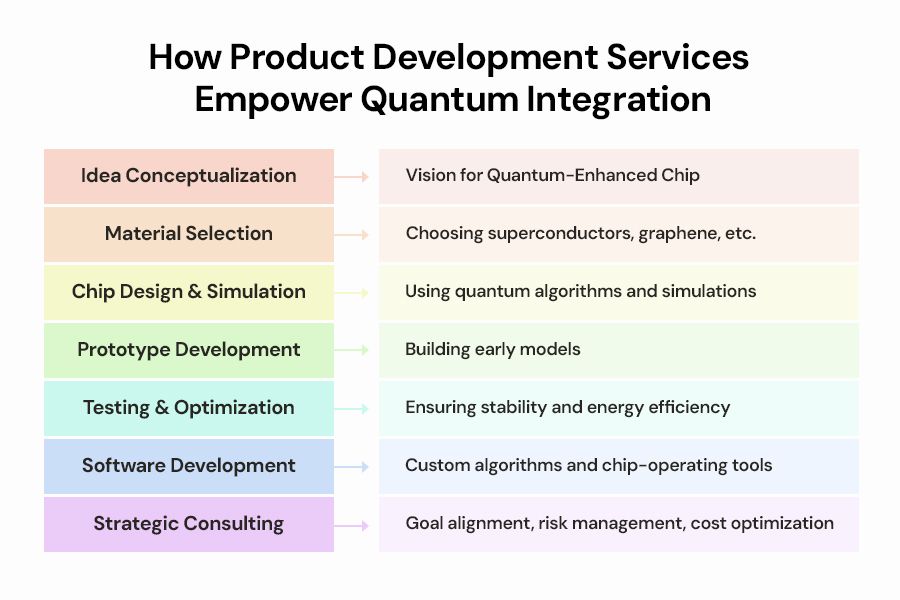Your smartphone could run a million times faster, and your laptop might solve complex problems in seconds instead of hours. This is the potential of quantum integration in semiconductor design. As our devices struggle to meet the growing demands for speed and efficiency, quantum technology offers a groundbreaking solution by reimagining how we build the chips that power our world. This article explores how quantum integration is shaping the future of semiconductors, the role of product development services in this shift, and what it means for businesses and consumers.
The Challenge of Modern Semiconductor Design
Semiconductors are the backbone of modern electronics. From smartphones to self-driving cars, these tiny chips process data, store information, and power our digital lives. But as technology advances, we’re hitting a wall. Traditional semiconductor designs, based on silicon and classical computing principles, are reaching their physical limits. Transistors—the building blocks of chips—are now so small that shrinking them further causes issues like heat buildup and power leakage. At the same time, industries like artificial intelligence, healthcare, and finance demand more computing power than ever before.
The problem is clear: we need a new approach to keep up with these demands. Enter quantum integration—a game-changing idea that combines quantum computing principles with semiconductor design to create faster, more efficient chips. But how does it work, and why does it matter? Let’s break it down.
What Is Quantum Integration in Semiconductor Design?
![]()
Quantum integration means using quantum mechanics—the science of how particles behave at the smallest scales—to improve how semiconductors are designed and built. Unlike classical computers, which use bits (0s and 1s) to process information, quantum computers use qubits. Qubits can exist in multiple states at once, thanks to a property called superposition. This allows quantum systems to perform many calculations at the same time, potentially solving complex problems much faster than traditional computers.
In semiconductor design, quantum integration involves creating chips that can work with quantum processors or use quantum-inspired techniques to boost performance. For example, quantum algorithms can optimize chip layouts, making them more efficient. Quantum materials, like superconducting circuits, can also be used to build chips that operate at incredibly low temperatures with minimal energy loss.
This isn’t about replacing every chip with a quantum one. Instead, it’s about blending quantum ideas into existing semiconductor designs to make them better. This hybrid approach is where product development services come in, helping companies navigate the complex process of designing, testing, and producing these next-generation chips.
Why Quantum Integration Matters
The benefits of quantum integration are significant. First, it promises faster chips. Quantum-inspired designs can process data more efficiently, which is critical for applications like machine learning, where massive datasets need to be analysed quickly. Second, it reduces energy use. As data centres consume more power globally, energy-efficient chips are a priority for both businesses and the environment. Third, quantum integration opens doors to new possibilities, like cracking complex problems in drug discovery or financial modelling that are too hard for classical computers.
For businesses, adopting quantum integration isn’t just about keeping up—it’s about staying ahead. Companies that invest in this technology now can gain a competitive edge, offering products that are faster, smarter, and more sustainable. But making this leap requires expertise, which is why many turn to product development consultants to guide them through the process.
The Role of Product Development Services

Building a quantum-integrated semiconductor isn’t like assembling a traditional chip. It involves new materials, advanced physics, and specialized manufacturing processes. This is where product development services shine. These services provide end-to-end support, from initial research to final production, helping companies turn ideas into reality.
For example, a company might have a vision for a quantum-enhanced chip but lack the in-house expertise to design it. Product development services can step in, offering teams of engineers, physicists, and designers who understand both quantum technology and semiconductor manufacturing. They can help with everything from selecting the right materials to testing prototypes, ensuring the final product meets industry standards.
Software product development services are equally important. Quantum-integrated chips often require custom software to operate, such as algorithms that take advantage of quantum properties or tools to simulate chip performance before manufacturing. These services create the software that makes quantum chips work, bridging the gap between hardware and real-world applications.
A product development consultant plays a key role in tying it all together. Consultants act as strategic advisors, helping companies define their goals, manage risks, and avoid costly mistakes. They might recommend focusing on a specific application, like optimizing AI workloads, or suggest partnerships with quantum research labs to access cutting-edge knowledge. Their expertise ensures that businesses don’t just experiment with quantum integration—they succeed at it.
How Quantum Integration Is Happening Today
Quantum integration is already underway, though it’s still in its early stages. Major players like IBM, Intel, and Google are investing heavily in quantum research, exploring ways to incorporate quantum principles into their chip designs. Startups are also making waves, developing specialized quantum chips for niche markets like cryptography or logistics.
One exciting example is the use of quantum annealing in chip design. Quantum annealing is a technique that uses quantum effects to find the best solution to complex problems, like arranging transistors on a chip to minimize heat. Companies working with product development services are using quantum annealing to create chip layouts that are more efficient than those designed with classical methods.
Another area of progress is quantum materials. Researchers are experimenting with materials like graphene and topological insulators, which have unique electrical properties that could make chips faster and less power-hungry. Product development consultants often help companies evaluate these materials, balancing their potential benefits against the challenges of manufacturing them at scale.
Challenges and Solutions
Despite its promise, quantum integration isn’t without hurdles. First, there’s the technical challenge. Quantum systems are incredibly sensitive to their environment—vibrations, temperature changes, or even stray electromagnetic waves can disrupt them. Designing chips that can handle these conditions requires precision and expertise.
Second, there’s a skills gap. Quantum technology is new, and there aren’t enough experts to meet demand. This is where product development services are critical, providing access to specialized talent that most companies don’t have in-house.
Third, quantum integration is expensive. Building a single quantum chip can cost millions, and the manufacturing process is still being refined. Product development consultants can help by identifying cost-saving strategies, like focusing on hybrid designs that combine quantum and classical elements to keep expenses manageable.
Finally, there’s the challenge of adoption. Businesses need to understand how quantum-integrated kle chips can benefit them, and that requires education. Software product development services can help by creating user-friendly tools and applications that show the value of quantum technology in practical terms.
The Future of Quantum-Integrated Semiconductors
Looking ahead, quantum integration is set to transform the semiconductor industry. In the next decade, we could see chips that are orders of magnitude faster and more efficient than today’s models. These chips will power everything from smarter AI assistants to breakthroughs in scientific research. For consumers, this means devices that are more powerful, last longer on a single charge, and can do things we can’t yet imagine.
For businesses, the opportunity is immense. Companies that embrace quantum integration now—through partnerships with product development services—will be well-positioned to lead their industries. Those that wait risk falling behind as competitors roll out quantum-powered products.
Governments and universities are also playing a role, funding research and training the next generation of quantum engineers. This collaborative effort will accelerate progress, making quantum-integrated chips more accessible and affordable over time.
Getting Started with Quantum Integration
If you’re a business looking to explore quantum integration, the first step is to define your goals. Are you aiming to build a faster chip for AI? Improve energy efficiency for data centers? Or explore a new market, like quantum cryptography? A product development consultant can help you clarify your vision and create a roadmap to achieve it.
Next, partner with product development services to access the expertise you need. These services can guide you through the design process, from choosing materials to prototyping and testing. If software is part of the equation, software product development services can build the tools and algorithms that bring your chip to life.
Finally, stay informed. Quantum technology is evolving quickly, and new discoveries are happening all the time. Working with a consultant ensures you’re always aware of the latest trends and opportunities.
Conclusion
Quantum integration is more than a trend—it’s the future of semiconductor design. By combining the power of quantum mechanics with traditional chip-making, we can create devices that are faster, more efficient, and capable of solving problems we once thought impossible. But getting there requires expertise, collaboration, and a willingness to embrace new ideas.
Product development services, software product development services, and product development consultants are essential partners in this journey. They provide the knowledge, skills, and strategic guidance needed to turn quantum dreams into reality.
Reimagine Semiconductor Design with Quantum Integration


